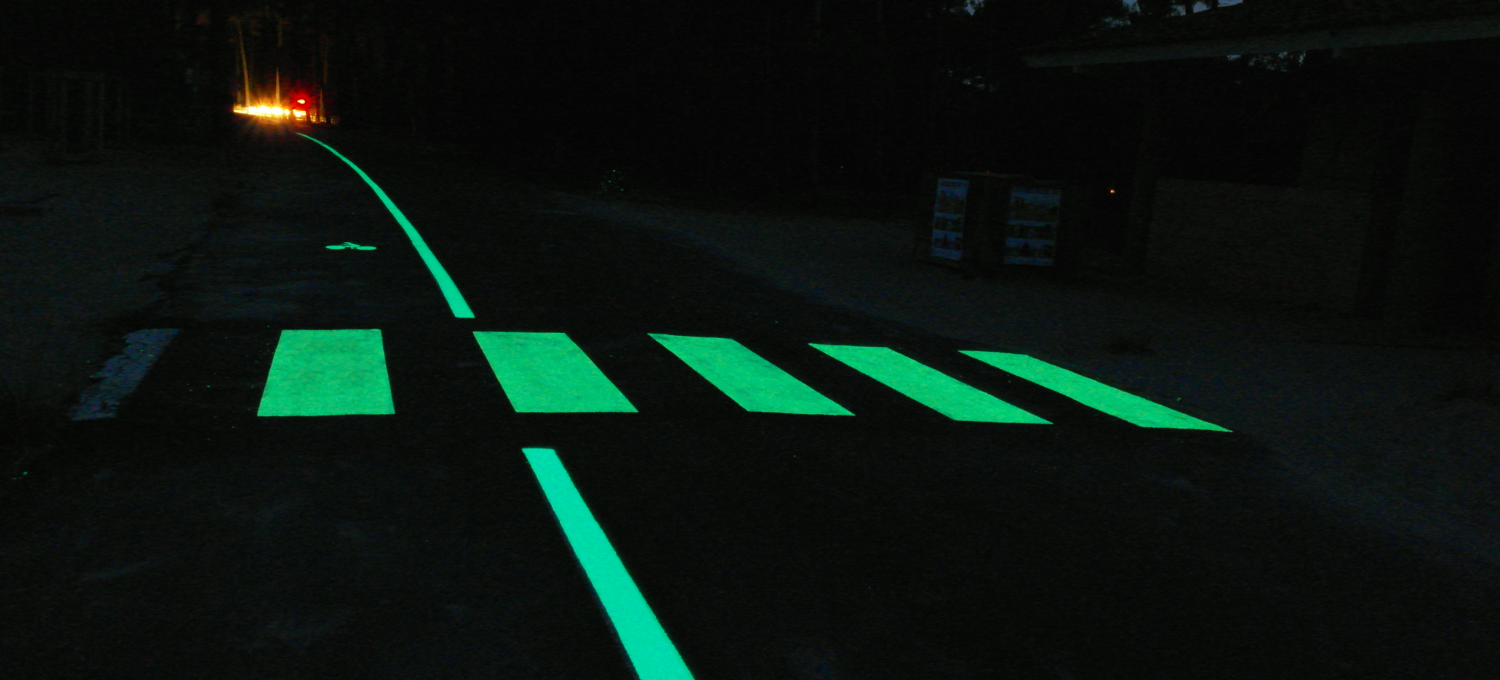Improving walker safety with illuminated pedestrian crossings
11 April 2024Table of content

At night, when visibility is poor, certain stretches of roadway, such as pedestrian crosswalks or intersections with traffic lights, can quickly become accident-prone zones for users, and road safety suffers as a result. Despite the many measures put in place by towns and cities, accidents involving vunerable users remain a major challenge, raising a crucial question:
How can the security of pedestrians at these crossings be improved?
Luminescent marking crosswalks have emerged in recent years as an innovative solution, promising to increase exposure and capture automobilists’ attention to reduce speed. By combining technology and performance, they offer an enlightened response to the pressing need to protect users, especially in the absence of lighting on roadway.
Contexts in which pedestrians are particularly vulnerable
In an ever-expanding urban public context, the density of vehicles and other traffic is constantly increasing, and road safety has become a major concern for towns and cities in France and around the world.
Every day, thousands of walkers cross unsignalised roads, facing risks that can be exacerbated by factors such as vehicle speed, driver inattention and, above all, poor visibility, particularly in unlit environments.
The protection of soft mobility at crosswalk, in particular, is a major concern. Despite the various measures already in place, accidents involving pedestrians remain frequent, and their severity often increases after sunset.
But how can pedestrian mobility on these crossings be made safer, especially in low-light conditions?
Pedestrian crossings, high-risk areas for pedestrians
 |
According to the Observatoire National Interministériel de la Sécurité Routière (French National Interministerial Road Safety Observatory), almost one pedestrian in two is killed on a pedestrian crossing in France! In fact, in 2021, of the 279 cases recorded in built-up areas, pedestrians were mainly killed on the carriageway on a pedestrian crossing (117 cases, or 42%) or less than 50 metres from a pedestrian crossing (77 cases, or 28%).
In 2023, an estimated 3,170 road deaths were recorded in mainland France. Of these victims, 423 were on foot. Despite an overall trend towards improved security for pedestrians, these figures clearly show that soft mobility users remain among the most vulnerable highway users on roadway. |
These previous statistics underline the continuing importance of efforts to improve pedestrian safety, in particular through innovations that can play a crucial role in reducing mortality and serious injury among this category of path user.
This vulnerability is felt most acutely when the sun goes down and visibility on the street begins to fail in a city without lighting. Traffic lights, sign intersections and urban signs become hard to see without lighting.
What if innovation will brought illuminance to our pedestrian crosswalks?
To make pedestrian crossings safer, a number of innovations have been developed in recent years, providing creative and technological solutions to this crucial urban issue. Here are some of the most interesting innovations and concepts:
- 3D protected crosswalk: Using a 3D perspective system, these pedestrian crossings create an optical illusion, giving drivers the impression that they are approaching an obstacle. This encourages them to slow down and reduce speed, thereby reducing the risk of accidents. However, their effectiveness can be limited in the darkness or in the rain, and they cost more to install and maintain than traditional crossings.
- Audible pedestrian crosswalk: This is certainly not a visual innovation, but an auditory one. Produced to improve the confidence of visually impaired or blind people, these pedestrian crossings emit audible signals to indicate when it is safe to cross. Some systems can be activated by push-button or remote control, contributing to a more inclusive positive city.
-
Intelligent pedestrian crosswalk: This product uses sensors and cameras to detect the presence of people and adjust the luminous signs on the ground or other panels accordingly. The system will adapt the duration of the green light for pedestrians according to the number of people waiting to cross, thereby helping to improve the flow of both pedestrian and vehicle traffic. This glow system shows how technology can contribute to more dynamic and responsive traffic management.
- Illuminated pedestrian crosswalk: These are equipped with glow marking or LED strips making pedestrian crossings more visible at night or in bad weather. They can be activated permanently or by motion detection using sensors as passers-by approach, encouraging drivers to slow down and adapt their behavior. Although they can be expensive, initial tests in France have shown an encouraging reduction in pedestrian fatalities. The Eure French department was one of the first to experiment with this type of illuminance technology.
Luminous crossings to make walking safer at night

Each of the previous innovations, such as the LED lights, aims to make urban mobility safer for users, taking into account the challenges posed by traffic density, the diversity of user needs, and variable environmental conditions. By continuing to develop such technologies, towns and cities can hope to significantly reduce accidents and improve the behavior and positive quality of life of their citizens.
It is against this backdrop that illuminated protected crossings appear to be a promising innovation, offering a technological response to a vital preserving issue. These devices, designed to increase the exposure of pedestrian crossings and attract the attention of drivers, offer a promising solution for reducing accidents and protecting lives.
Significant safety benefits thanks to illuminated marking
Glow in the dark pedestrian crosswalk will offer a number of advantages over traditional solutions and lights, mainly in terms of safety and exposure on roadway. Here are the main positive benefits identified:
- Improved visibility: LED lights or luminescent marking will attract drivers’ attention much better than standard road marking, especially in the dark or in bad weather, reducing the risk of accidents due to lack of exposure.
-
Increased awareness: By making pedestrian crossings more visible and attractive, drivers are more likely to be aware of their presence and to reduce their speed and adapt behavior, even on roads where they had not previously identified the pedestrian crossing.
- Improved safety in a variety of conditions: Glow pedestrian crossings bring an effective system for improving confidence in a variety of situations, such as in low light or when lighting is reduced due to adverse weather conditions
- Potential reduction in pedestrian fatalities: Initial tests and deployments in some cities are showing encouraging and positive results in terms of reductions in pedestrian fatalities and accidents, suggesting a strong potential for these lights technologies as part of an overall safety policy.
LuminoKrom® luminescent paint for pedestrian crossings
LuminoKrom® photoluminescent paint offers significant benefits for the safety and exposure of protected walkways. It captures daylight and returns it in the dark, enhancing the visibility of pathways in areas where there is no system of street lighting.
This eco-sustainable technology consumes no electricity and is visible for more than 10 hours after being charged during the day, even in conditions of low light or cloud cover. What’s more, LuminoKrom® helps to guide soft mobility at night on roadway and warn them of nearby dangers, contributing to their peace of mind when travelling at night.

Discover the luminescent crosswalk
The French Somme department has chosen luminescent paint for one of its pedestrian crossings.
The Somme Departmental Council is building a LuminoKrom® photoluminescent pedestrian crossing in front of a secondary school to improve the peace and quiet of students and other passers-by.
Work began in April 2021 in front of Bernaville secondary school. The Conseil départemental de la Somme took advantage of the works on the RD66 in front of Bernaville secondary school to test two innovative processes: a fibre-reinforced asphalt surface designed to reduce noise pollution, and LuminoKrom® photoluminescent paint to improve user safety and reduce speed.
LuminoKrom® photoluminescent paint is part of the emerging infrastructure of the future, which must be safer, more economical and more environmentally responsible. Automobilist behavior changes positively due to the presence of luminescent paint.
LuminoKrom® exploits the natural phenomenon of photoluminescence. This physical process enables the paint to capture light during the day and create a luminous guide in the dark, without consuming any electricity or emitting any CO2. Our technology is particularly adadpted to places without lights development.
The only patented photoluminescent paint
LuminoKrom® is currently the only patented photoluminescent paint on the market capable of emitting diffuse luminosity in the dark, visible for more than 10 hours.
LuminoKrom® luminous coatings have been designed to meet the challenges of safety and visibility. During the day, the light emitted by the sun makes it possible to see, to situate oneself in space, to direct oneself, to avoid obstacles and to recognise oneself.
The integration of technology into road safety, as in the case of illuminated pedestrian crossings with LED signs and lights such as those at Les Andelys (Eure department), or luminescent signage, opens the way to continuous improvements through innovation. Systems can be updated or adapted with new features to further enhance the safety of vulnerable soft mobility users.
By combining improved exposure with intelligent use of technology, illuminated pedestrian crossings represent a promising step towards safer towns and cities for walkers. They illustrate how innovation can play a key role in preventing accidents and protecting the most vulnerable highway users.









